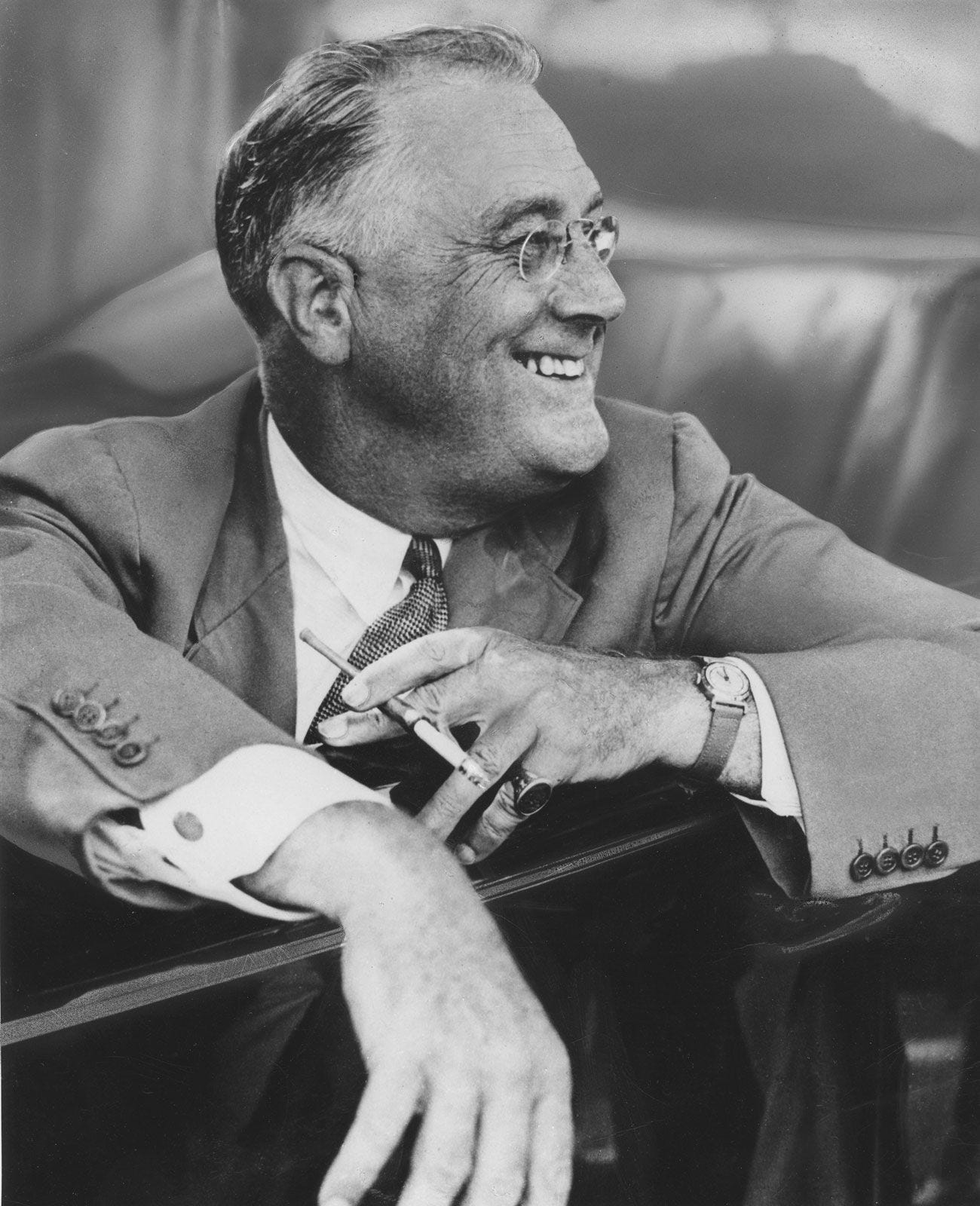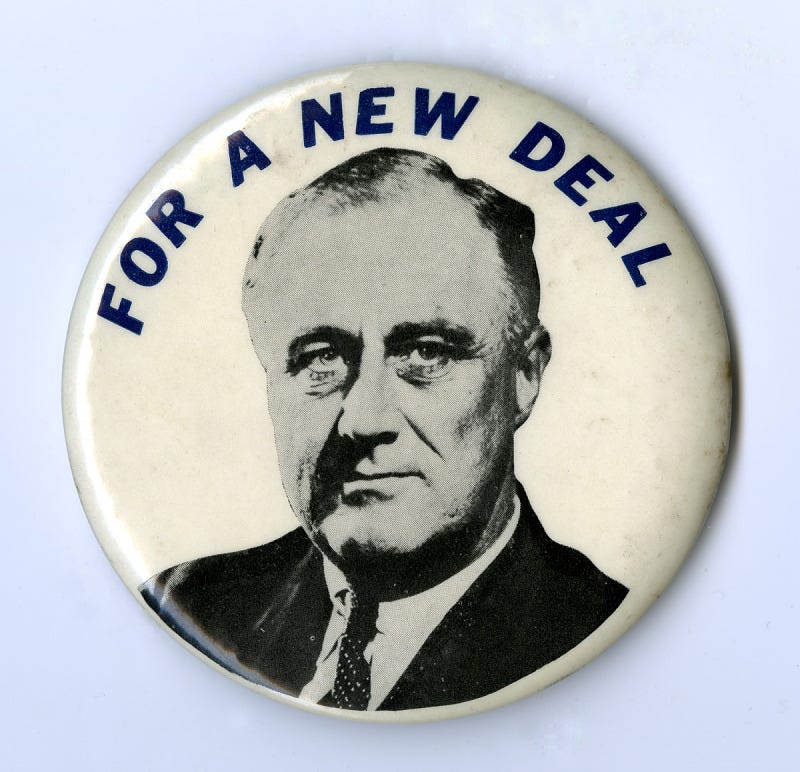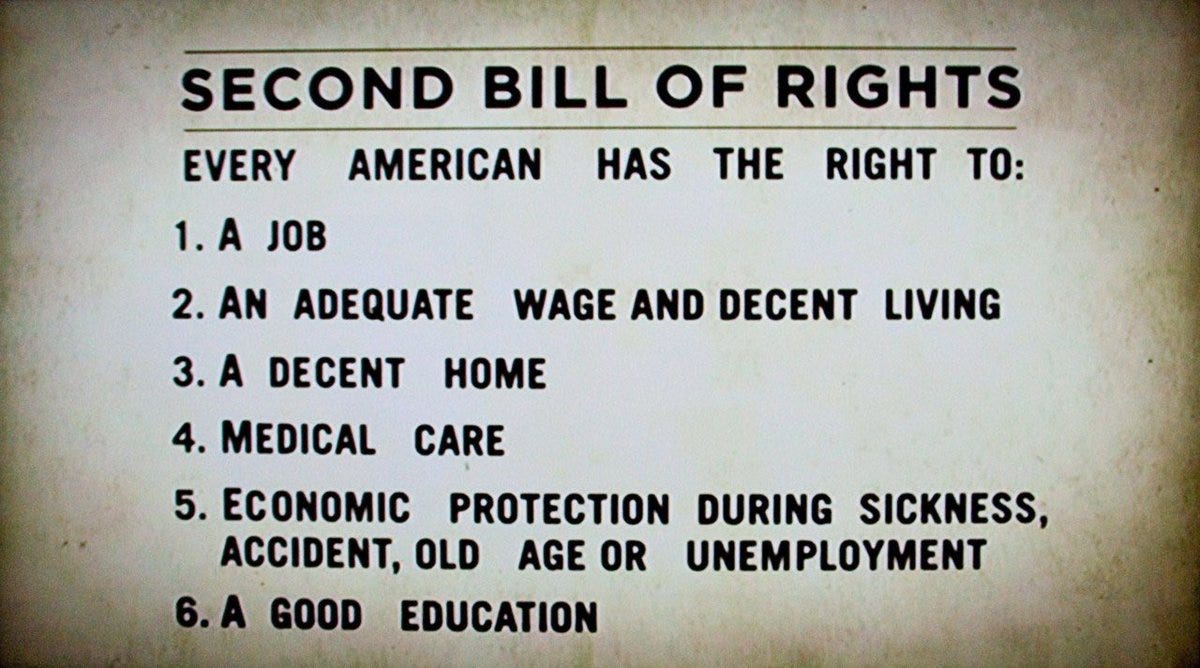Democrats Don't Need to Reinvent the Wheel to Solve Their Identity Crisis - They Need to Look Back to FDR
Neoliberalism has run its course. We need a return to Keynesianism.
When looking at the Democratic Party today, it’s easy to forget that it was once the dominating force in American politics for decades. From 1933 until 1969, the country had only one Republican president. Democrats controlled both houses of Congress for all but four years between 1933 and 1981.
This complete domination of national politics seems even more surprising when you consider the fact that only two Democratic presidents - Grover Cleveland and Woodrow Wilson - held the presidency from 1877 to 1932. After the Wilson presidency, the Democratic Party was on the backfoot after several crushing defeats in a row. So how did the party go from the brink of absolute defeat and total irrelevance to the juggernaut that dominated Mid-Century American politics?
It all started with Franklin Delano Roosevelt (FDR).
Roosevelt existed in a strange and fluid era in American politics. While his fifth cousin (and idol) Theodore Roosevelt had been an unapologetic progressive who favored strong labor rights and environmental protections, the GOP as a whole had been cozying up to big business and favoring laissez faire economics for decades. At no point had this become clearer than during the Harding, Coolidge, and Hoover administrations of the roaring 20s. The Progressive Era of the early 1900s (T. Roosevelt, Taft, and Wilson) had been replaced by a Second Gilded Age. The result was abhorrent inequality, loosening regulations, and a government run by corporate interests and for corporate interests. Sound familiar?
The ultra rich partied their way through the 20s (just as they had during the Gilded Age) and carried on without a care in the world, while the working class suffered. Then came the Great Depression.
Many of President Herbert Hoover’s attempts at alleviating the crisis, such as signing the protectionist Smoot-Hawley Tariff Act, only made things worse. Trade plummeted, and the U.S. sank further into the Depression. While the Act’s proponents had promised prosperity, the tariffs raised prices and actively made the situation worse. Again, sound familiar?
Riding a wave of anti-Republican sentiment, FDR defeated Hoover in a massive landslide in 1932. Instead of opting for business as usual, Roosevelt chose to completely revamp the Democratic Party to address the crisis at hand. Starting with the Emergency Banking Act, which averted a complete collapse of the banking system during his first week in office, FDR pushed through 15 historic pieces of legislation during his first 100 days in a marathon session of Congress. But this was only the beginning. He understood that people needed action and that nothing short of a complete overhaul of both the Democratic Party and the American government itself would do. The excesses of capitalism had been allowed to run unchecked for too long, and a course correction was needed if the nation was going to survive.
FDR promised change. And then he did the craziest thing - he actually delivered.
A rich, privileged New Yorker proved himself more economically progressive than any president before him. He established the minimum wage, 40-hour work week, and overtime pay. He ended child labor. He put millions of Americans to work through programs like the CCC, which resulted in the planting of billions of trees, combating soil erosion on 84 million acres of farmland, protection of 154 million square yards of stream and lake shores, and revegetation of 814,000 acres of range. He created Social Security, which has served as a vital lifeline for the elderly, disabled, spouses and children of the deceased, and more for nearly a century. He granted private sector employees the legal right to unionize, collectively bargain, and strike.
Unemployment peaked at nearly 25% when Roosevelt took office. It was down to 10% by 1941, before the U.S. had entered World War II. By 1944 (Roosevelt’s last full year in office), it was down to 1.2%.
Labor had grown used to an antagonist government (to the point where the U.S. Government even bombed its own citizens in 1921). In Roosevelt, it found a friend.
As FDR noted in 1936, “We know now that Government by organized money is just as dangerous as Government by organized mob.”
He continued: “Never before in all our history have these forces been so united against one candidate as they stand today. They are unanimous in their hate for me—and I welcome their hatred.”
Not only had the Democrats found their champion, but the American people had finally found a leader who was willing to put them first. Instead of caving to the ultra-wealthy, FDR instituted the most progressive tax rate in American history. He ensured that the people who had made their fortunes exploiting the working class would bear the burden of paying for his social safety nets. The Revenue Act of 1935 imposed an income tax of 79% on annual incomes over $5 million - an amount so high that only John D. Rockefeller was affected at the time.
Near the end of WWII, the top marginal income tax rate reached 94% on income over $200,000. Decades of conservative propaganda have made such rates seem unthinkable today, but this progressive taxation structure worked wonders and helped spur the prosperity of the decades that followed. This era, commonly dubbed “the New Deal era” or Fifth Party System, was defined by a flourishing middle class and massive economic growth. Today, many Republican politicians who glorify this era conveniently leave out the fact that Roosevelt’s policies helped make it possible. Recent calls for much lower marginal tax rate increases have been immediately derided as “radical” and “socialist.”
As he put it in his second inaugural address, FDR saw “one-third of a nation ill-housed, ill-clad, ill-nourished” and was “determined to make every American citizen the subject of his country’s interest and concern.” He took no vote for granted and used his power to demonstrably improve the lives of Americans. And the people wouldn’t forget it.
In 1936, Roosevelt won one of the biggest landslides in American history. FDR carried all but two states and won 523 electoral votes compared to challenger Alf Landon’s eight. He then proceeded to win two more landslide elections. While his decision to break the two-term precedent remains controversial to this day, he was not the first to try. He was just the first to succeed, and he did so because the country loved his policies.
Those policies remained so popular that the Democrats controlled the presidency for all but eight years from 1933 to 1969, and the one Republican president during this period - Dwight D. Eisenhower - kept virtually all of Roosevelt’s New Deal policies intact. The most significant expansion of FDR’s legacy came under Lyndon B. Johnson’s presidency, with notable achievements including the Social Security Amendments of 1965, which established Medicare and Medicaid.
The New Deal Democrats were a dominant force for half a century. Unfortunately, Vietnam began their downfall, the Southern Strategy expedited it, and the Reagan presidency cemented it. Bill Clinton and the rise of Third Way politics laid the nail in the coffin. Since the 80s, the Democratic Party has embraced corporatism over true economic progressivism, and has lost its identity in the process. The “people’s party” became the “corporate donor’s party.” And voters noticed.
Now, while voters are begging for a change, many Democrats continue to advocate for the status quo - with some even suggesting that the party move away from small donors in favor of courting wealthy elites even more aggressively.
The Republican Party of 2025 is not the Republican Party of 1980. So why is the Democratic Party the same one?
FDR died 80 years ago, and yet he remains the most economically progressive president in U.S. history. His proposed “2nd Bill of Rights” (see below) laid the groundwork for Democratic success and American prosperity.
Unfortunately, Roosevelt died soon after this proposal, and never had the chance to see it through. Although multiple presidents, such as Truman and Johnson, tried to continue FDR’s legacy and implement laws to make many of these provisions a reality, the gains made by the working class during the New Deal era have been clawed back significantly in recent decades.
Donald Trump offered faux populism to the American people and promised a return to greatness, all while gutting critical programs like Medicaid and shifting even more of the tax burden from the rich to the poor. He continues to glorify mid-19th Century America while promoting policies that are antithetical to the ones that helped create the American middle class and promote the prosperity of the era.
The end result is that much of the American public - already spread thin and struggling to make ends meet - finds itself squeezed even tighter. Trump utilized voter malaise and anger over four decades of neoliberalism to get into power, then doubled down on tax breaks for the rich and the erosion of social safety nets. Despite his populist rhetoric, Trump is as much a billionaire’s president as there has ever been. His praise for the Gilded Age should come as no surprise.
What the American people really need is a return to New Deal era economic progressivism. What they’re getting is a Democratic Party obsessed with shifting toward the “middle” to meet a Republican Party that (1) has moved so far right that the Overton Window is unrecognizable and (2) has no interest in compromising or negotiating in good faith. We saw this clearly during the Biden presidency.
As a recent poll found, voters who sat out the 2024 election wanted candidates who were more left-wing. Today’s “far left” politicians in the U.S. would have been right at home in the Democratic Party of the 30s-70s (at least from an economic standpoint), and yet they are dismissed as radicals by mainstream Republicans and Democrats alike.
Few would disagree that the Democratic Party is in desperate need of fresh energy and new ideas. But why spend endless time, effort, and money on figuring out a new strategy when the starting point has been right in front of us for nearly a century?
FDR was a product of his time in many ways, and his presidency (and policies) were not perfect. There are plenty of valid criticisms to be made of his economic policies, like the fact that the benefits were not reaped equally by the public (see: redlining). Praise for FDR’s vision is not an endorsement or defense of such injustices.
We can expand and build upon these ideas, while implementing them in such a way that all Americans benefit. The New Deal era doesn’t have to be the end. It could be the beginning of something greater.
“The test of our progress is not whether we add more to the abundance of those who have much; it is whether we provide enough for those who have too little.” - FDR






I completely agree with the idea that Democrats don’t need to reinvent themselves. They just need to remember who they’re supposed to be. The party’s strongest moments came when it stood up for working people, fought inequality, and pushed bold change.
History rhymes, and right now, we’re seeing the same kind of economic stress and public frustration that led to FDR and the New Deal. People are fed up. Not just with Trump, but with a Democratic Party that often feels out of touch. That anger and disappointment could actually be the spark we need.
I’m hopeful that by 2028, a strong progressive candidate will emerge. Someone who speaks clearly to everyday struggles and offers real solutions. Like FDR rising from crisis, I think the next big wave of change is possible. The energy is there. We just need the courage to go big again.